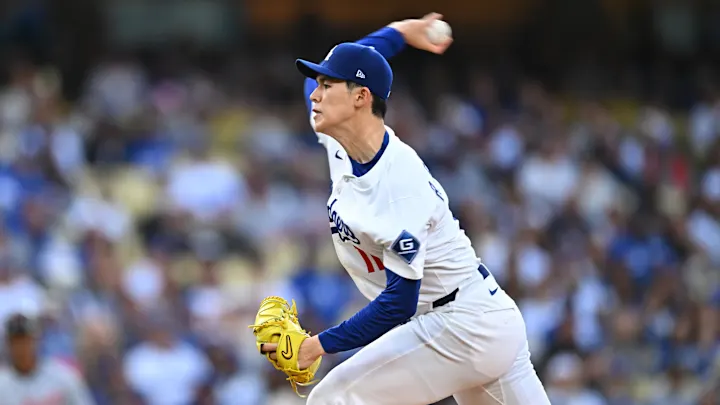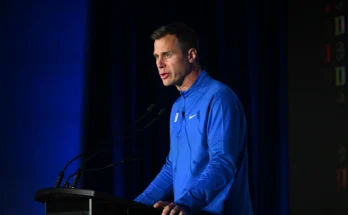After a poor start to the season, Dave Roberts controls Roki Sasaki.
The art of managing young pitching talent is one of the most delicate aspects of a manager’s job in Major League Baseball. While fans and analysts alike eagerly watch the rise of phenoms like Roki Sasaki, it’s easy to forget that these young arms are not immune to struggles. Sasaki, a highly-touted Japanese pitcher, came to the Los Angeles Dodgers with high expectations after a stellar career in Japan. However, after a shaky start to the season, manager Dave Roberts was tasked with guiding Sasaki through the growing pains of MLB life. Through careful communication and strategic decision-making, Roberts took control of the situation, adjusting Sasaki’s role and workload in a way that not only preserved the pitcher’s development but also allowed him to regain his form.
The Rise of Roki Sasaki
Roki Sasaki was a sensation in Japan before ever stepping foot in the Major Leagues. A young, dominant pitcher for the Chiba Lotte Marines, Sasaki made headlines for his ability to throw 100 mph heat and his devastating slider. He earned comparisons to some of the greats in the game, with a potential to become one of the best pitchers in MLB. By the time the Dodgers signed Sasaki, they knew they were acquiring a talent with the potential to be a cornerstone of their rotation for years to come.
Sasaki’s transition to Major League Baseball was highly anticipated. His time in Japan was marked by unparalleled success, and many were eager to see if he could replicate that form on the big stage. However, the transition from the NPB to MLB is no small feat. The increased competition, the mental toughness required, and the pressure of living up to enormous expectations can weigh heavily on any young player.
The Struggles at the Start of the Season
Despite all the hype, Sasaki’s start to the season in MLB was not smooth. The highly-regarded pitcher experienced some growing pains on the mound. His velocity was there, but his command of the strike zone wasn’t as sharp as it had been in Japan. His ERA soared, walks increased, and he struggled to make it deep into games. The once-promising ace looked lost at times, and the Dodgers began to question whether he was ready to handle the challenges of MLB.
In his first few outings, Sasaki showed flashes of brilliance but was inconsistent. His stuff was elite, but his control was erratic, and hitters often made him pay for leaving pitches in the wrong spots. The Dodgers had a problem on their hands—Sasaki was undeniably talented, but he was struggling to find his rhythm in the Major Leagues. For a team that was in the middle of a highly competitive season, finding a way to help Sasaki regain his confidence became a critical issue.
Dave Roberts: A Manager Who Knows How to Handle Pressure
Dave Roberts has been the Dodgers’ manager since 2016 and has developed a reputation for being calm under pressure. His leadership style is often described as collaborative and supportive. He is known for creating a positive environment for his players, offering guidance while giving them the freedom to grow and evolve. It is this philosophy that made him the ideal person to take control of Sasaki’s situation when the young pitcher hit a rough patch.
Roberts’ experience with managing young talent is extensive. He’s worked with several of the Dodgers’ top prospects over the years, including star pitchers like Julio Urias, Walker Buehler, and Dustin May. Each of these pitchers had their own struggles and challenges as they made the transition to the majors, and Roberts proved adept at helping them work through their issues.
This experience was key when it came to managing Sasaki. Roberts understood that young pitchers need time and support to develop. While many might have been quick to send Sasaki down to the minors or demote him to a bullpen role, Roberts chose a different approach—one that focused on building Sasaki’s confidence and helping him adjust to the demands of MLB.
The Decision to Control Sasaki’s Workload
One of the first steps Roberts took was to control Sasaki’s workload. Instead of pushing Sasaki to continue starting every five days, Roberts decided to scale back the number of innings the young pitcher was throwing. This was a critical decision. Many young pitchers, especially those coming from international leagues, have trouble adjusting to the rigorous schedule of the MLB season. The grind of pitching every five days in the big leagues can be exhausting, especially when a pitcher is struggling to find consistency.
By controlling Sasaki’s workload, Roberts gave him the opportunity to focus on refining his mechanics without the pressure of being the team’s ace. The decision to reduce his innings wasn’t about punishing Sasaki—it was about preserving his long-term potential while helping him find his footing. This also allowed the Dodgers to use Sasaki in a more flexible role, which could include spot starts or bullpen appearances, depending on the situation.
Communicating with Sasaki
Managing a young player’s mental and emotional health is just as important as managing their physical health. Roberts recognized that Sasaki’s struggles weren’t just about his mechanics—they were also about his mindset. The pressure of being labeled the next big thing can weigh heavily on any young player, and Roberts understood that mental health and confidence were key to Sasaki’s development.
Roberts took the time to sit down with Sasaki, offering words of encouragement and support. He helped the young pitcher understand that setbacks were a natural part of the game and that no one could expect perfection right away. This communication helped Sasaki relax and refocus on what he could control: his preparation and his mentality. Roberts also made sure Sasaki had the right support from the coaching staff, including pitching coach Mark Prior, who worked with Sasaki on refining his mechanics and focusing on the fundamentals.
Adjustments in Sasaki’s Role
The Dodgers decided to adjust Sasaki’s role in the bullpen for a short period, giving him a chance to pitch in less-pressure situations while continuing to work on his control. This gave Roberts and the coaching staff a chance to evaluate Sasaki from a different perspective and to gauge his ability to handle shorter, more intense bursts of work. It also allowed Sasaki to regain his confidence in lower-leverage situations before being reintroduced to the starting rotation.
Sasaki’s adjustment to the bullpen was not just a temporary fix—it was a calculated decision to help him refine his mechanics and his mental approach. Roberts and the coaching staff understood that young pitchers often struggle with consistency, and giving Sasaki a break from the pressure of being a regular starter could provide the reset he needed.
Sasaki’s Recovery and Growth
After a brief adjustment period, Sasaki returned to the starting rotation with a renewed sense of confidence. His control had improved, and he began to resemble the pitcher that made him a star in Japan. With Roberts’ management, Sasaki was able to regain his rhythm and start stringing together solid performances. He didn’t become the dominant pitcher that many expected overnight, but he began to show flashes of his potential.
By the middle of the season, Sasaki had settled into a much more consistent groove. His ERA dropped, his walks decreased, and his strikeouts increased. The Dodgers’ patience and Roberts’ steady hand were paying off, as Sasaki began to turn things around and prove that he was indeed capable of handling the demands of Major League Baseball.
The Impact of Roberts’ Management
Roberts’ management of Sasaki demonstrated his ability to adjust on the fly and keep the long-term goals of player development in mind. His decision to scale back Sasaki’s workload and allow him to adjust mentally and physically paid dividends, not only for Sasaki but for the entire Dodgers organization. The team could rest easy knowing that their young pitching prospect was receiving the guidance and support he needed to become a key contributor in the future.
Moreover, Roberts’ approach showed the value of patience in a league that often demands immediate results. Instead of rushing Sasaki into the fire or giving up on him after a few bad starts, Roberts took a more methodical, strategic approach. This approach has not only helped Sasaki’s growth but also cemented Roberts’ reputation as a manager who can navigate the challenges of managing young talent.
The Future for Sasaki
As Sasaki continues to develop, the Dodgers are optimistic about his future. His struggles early in the season were a setback, but they have become a learning experience. With Roberts at the helm, Sasaki is on the right path toward becoming a key member of the Dodgers’ pitching staff for years to come. As Sasaki refines his skills and gains more experience in the big leagues, he will undoubtedly become a force to be reckoned with.
In the long run, the decision to control Sasaki’s workload and give him the space to develop may go down as one of the best managerial decisions of the season for the Dodgers. It demonstrated the value of patience, understanding, and flexibility in the face of adversity. For Roki Sasaki, his journey to MLB stardom is far from over, and with Dave Roberts guiding him, the future looks bright.
In the world of professional baseball, young talent often faces pressure that can lead to early struggles. Roki Sasaki’s poor start to the season could have been a defining moment, but thanks to Dave Roberts’ thoughtful management, Sasaki was able to overcome his difficulties and begin to develop into the pitcher everyone knew he could be. By controlling Sasaki’s workload, communicating openly, and providing him with the time and space to grow, Roberts set a clear example of how to nurture young talent through adversity. The Dodgers, under Roberts’ leadership, have once again shown that with the right guidance, even the most promising young players can realize their full potential.



